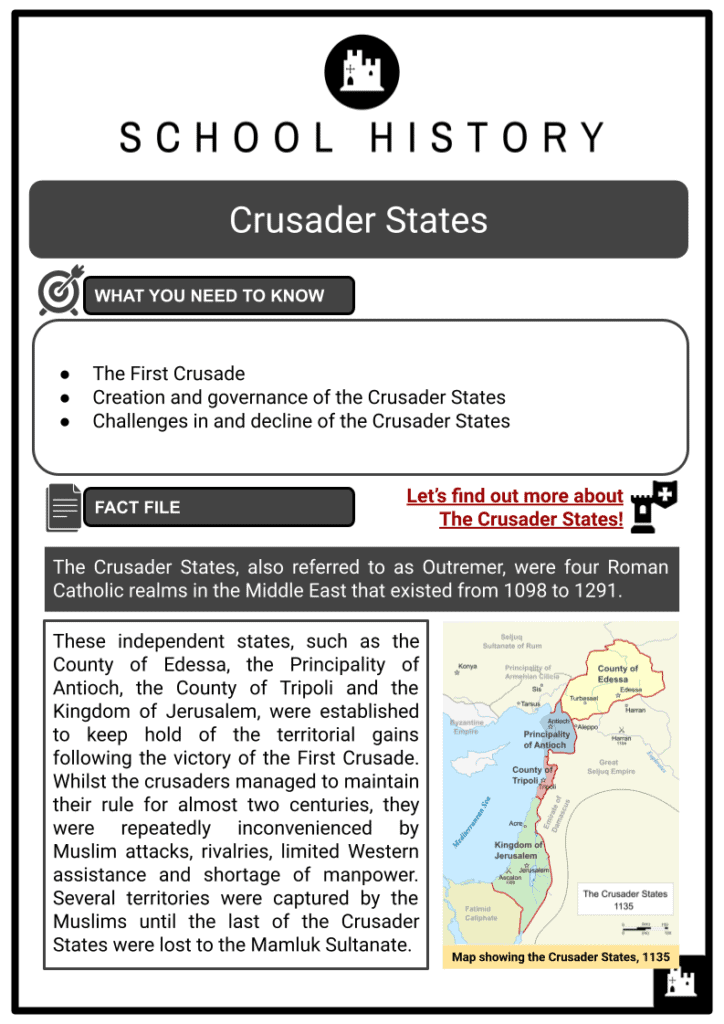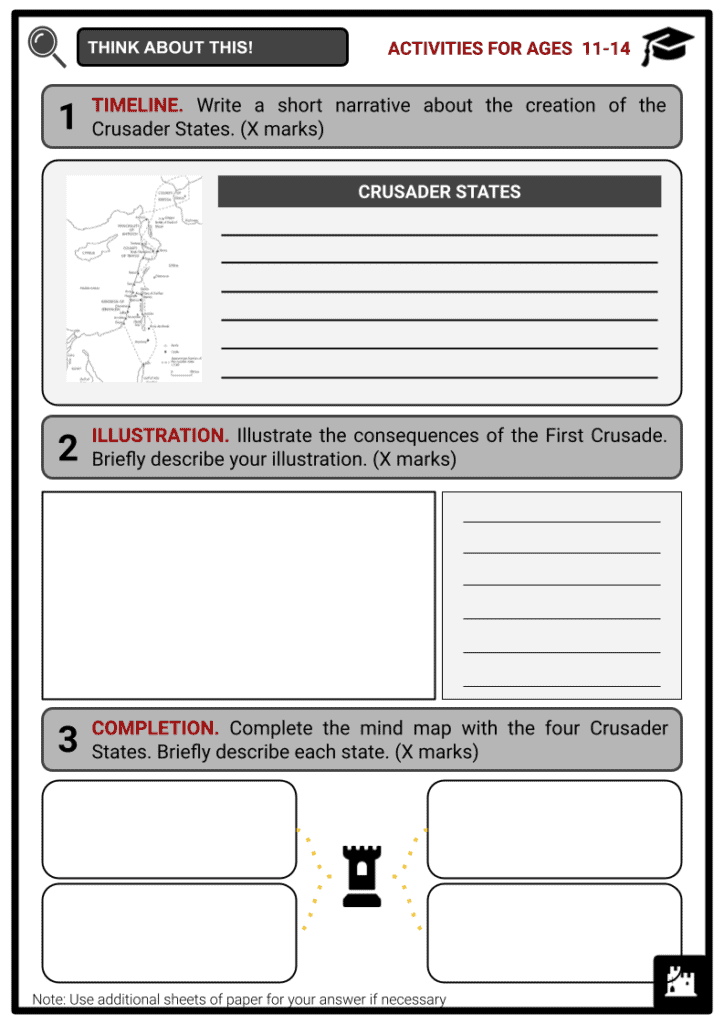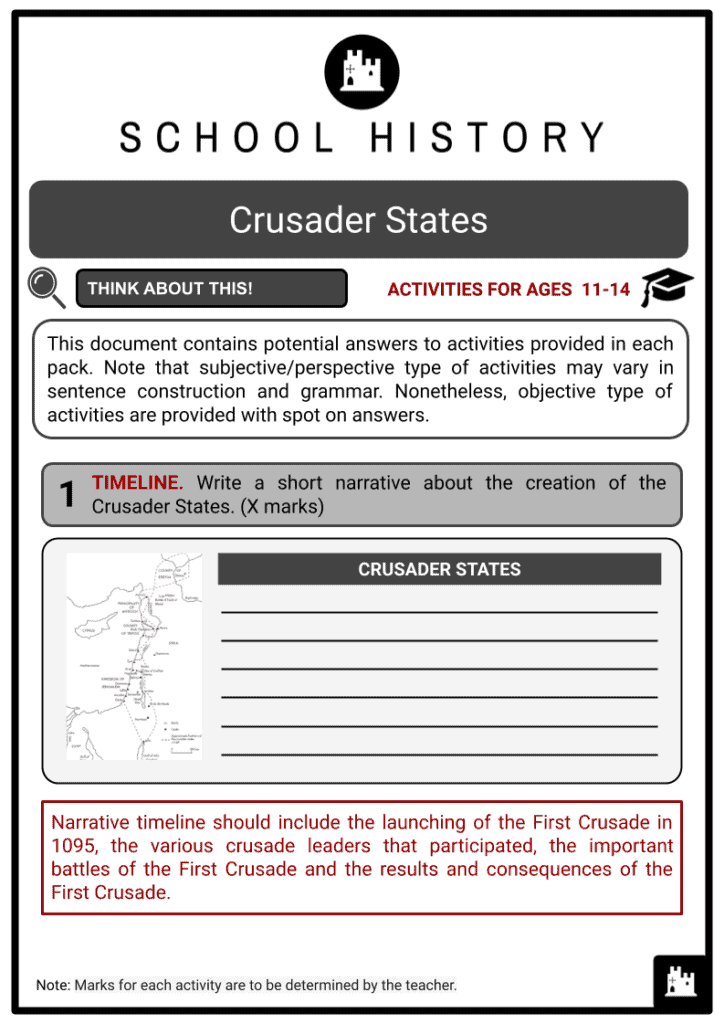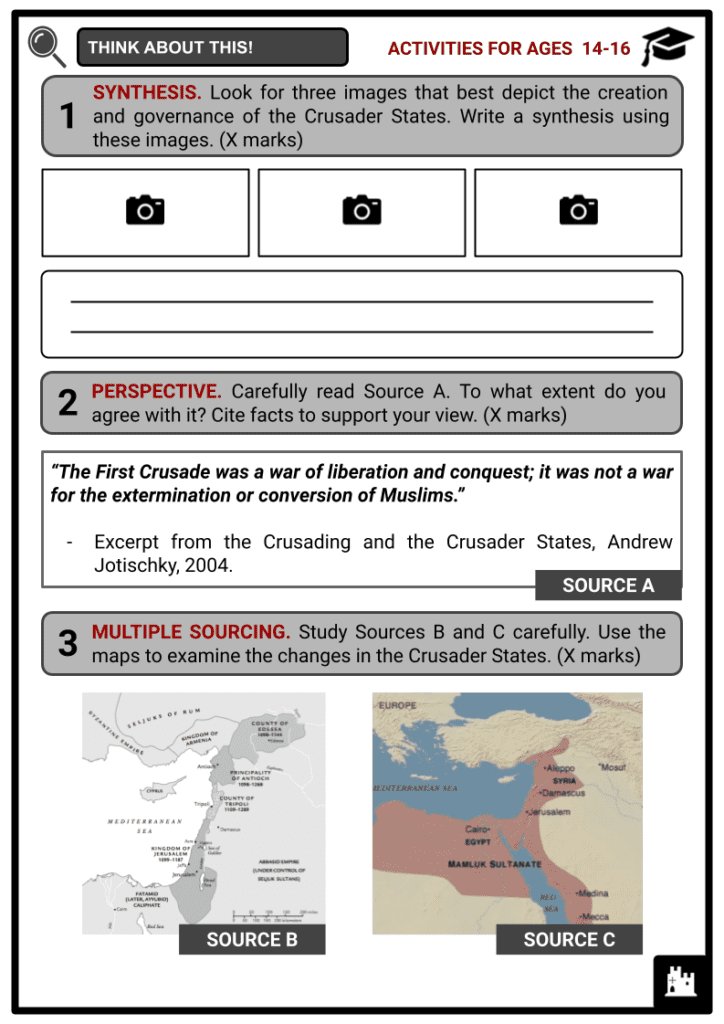Download the Crusader States
Do you want to save dozens of hours in time? Get your evenings and weekends back? Be able to teach about the Crusader States to your students?
Our worksheet bundle includes a fact file and printable worksheets and student activities. Perfect for both the classroom and homeschooling!
Summary
- The First Crusade
- Creation and governance of the Crusader States
- Challenges in and decline of the Crusader States
Key Facts And Information
Let’s find out more about The Crusader States!
- The Crusader States, also referred to as Outremer, were four Roman Catholic realms in the Middle East that existed from 1098 to 1291.
- These independent states, such as the County of Edessa, the Principality of Antioch, the County of Tripoli and the Kingdom of Jerusalem, were established to keep hold of the territorial gains following the victory of the First Crusade. Whilst the crusaders managed to maintain their rule for almost two centuries, they were repeatedly inconvenienced by Muslim attacks, rivalries, limited Western assistance and shortage of manpower. Several territories were captured by the Muslims until the last of the Crusader States were lost to the Mamluk Sultanate.
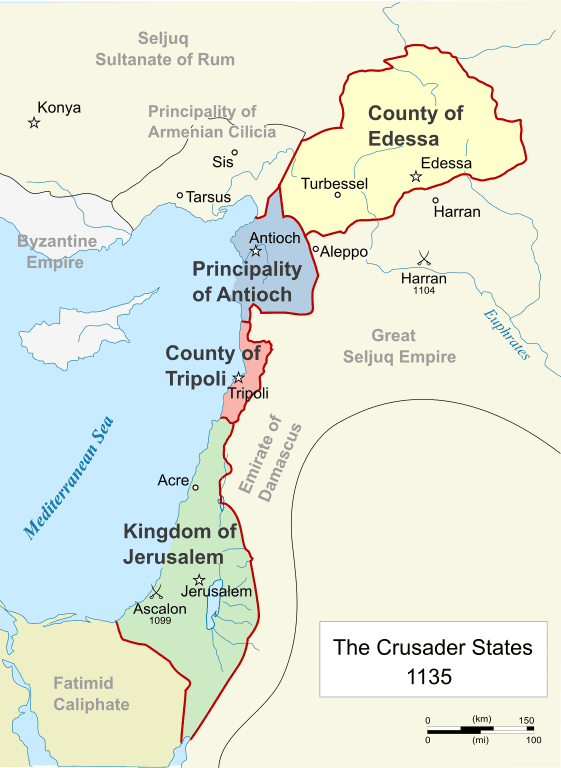
The First Crusade
- The First Crusade was invoked by Pope Urban II in 1095 in response to the rise of the Muslim Seljuk Turks in the Middle East and their capture of Jerusalem in 1087.
- The idea of the crusade originated when the Byzantine Emperor Alexios I Komnenos appealed to the West to help him repel the Turkish invaders advancing in Anatolia.
- In response, Urban II called the Council of Clermont and, on 25 November 1095, officially declared the crusade.
- An additional objective later became the main objective of the expedition: the Christian reconquest of the sacred city of Jerusalem, the liberation of Eastern Christians from Muslim rule.
- Following Urban II’s rallying speech, crusader armies were rounded up numbering around 60,000 men and including some 6,000 knights.
- The crusaders from various places were gathered by different leaders such as Peter the Hermit, Bishop of le Puy, Raymond IV Count of Toulouse, Robert Count of Flanders, Robert Duke of Normandy, Godfrey of Bouillon and the Norman Bohemond.
Battle of Nicaea
- In the first half of 1097, crusader armies joined Peter the Hermit in Asia Minor and captured Nicaea, capital of the Seljuks Sultanate of Rum.
Siege of Antioch
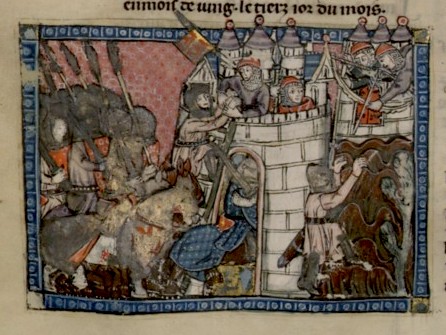
- On the way to Jerusalem, the crusader army reached Antioch. Besieging the city was difficult due to lack of supplies and extreme winter conditions. But due to internal conflict and Bohemond’s negotiation with a traitor, Antioch finally fell after an 8-month siege.
Capture of Jerusalem
- By December 1098, the Crusaders marched to Jerusalem and arrived in mid-1099. After several weeks, they captured the city. Bohemond, on the other hand, went back to Italy and convinced Pope Paschal II and King Philip I of France that the real threat to the Christian world was the Byzantines.
Results of the First Crusade
- With Crusader victory, the crusaders were treated as heroes.
- Muslim and Jewish population in Jerusalem including women and children were massacred.
- Godfrey of Bouillon was chosen as the new ruler of Jerusalem.
- The First Crusade served as inspiration to Western Christians to fight the infidels.
Creation and governance of the Crusader States
The major consequence of the First Crusade was the re-establishment of Christian rule over many parts of the Holy Land, including Edessa, Antioch, Tripoli, and Jerusalem. Instead of returning the retrieved Byzantine land to the emperor, crusaders claimed the land and established the Crusader States known as Outremer. These Christian-controlled independent states were mostly populated by Byzantine, Syrian, and population of Muslims and Jews, plus the new Western settlers.
What were the Crusader States?
County of Edessa, 1098–1150
- In March 1098, Baldwin of Boulogne and his 60 crusader knights seized the control of Edessa from the Christian Armenians.
- The County of Edessa, the first and the most integrated of the Crusader States, was formed.
- Baldwin allowed the mixing of Western and Armenian nobility through marriages.
- The County of Edessa was a vassal state to the more important and powerful Latin polities of Antioch and Jerusalem, serving as a military shield to Antioch.
Principality of Antioch, 1098–1287
- The Norman Bohemond led the capture of Antioch in 1098, while Tancred of Lecce his nephew and successor expanded the territory by taking the cities of Tarsus and Latakia from the Byzantine Empire.
- A close alliance between the Principality of Antioch and the Byzantine Empire was sealed in 1161 with the marriage of the daughter of Raymond of Poitiers, Maria of Antioch, to Emperor Manuel I.
- Due to the principality’s historical ties to the Byzantine Empire, a majority of its population was made up of Eastern Christians.
County of Tripoli, 1102–1289
- The County of Tripoli was founded by Raymond IV, Count of Toulouse and Saint-Gilles, after a lengthy siege in 1102 with the aid of Alexios I.
- Owing to Raymond IV’s oath of loyalty to the Byzantine emperor, Byzantine influence was allowed in the county.
- The County of Tripoli was the most independent of the Crusader States.
- However, it was perhaps the weakest, politically speaking, because of the semi-independent lordships that were established in the region.
Kingdom of Jerusalem, 1099–1291
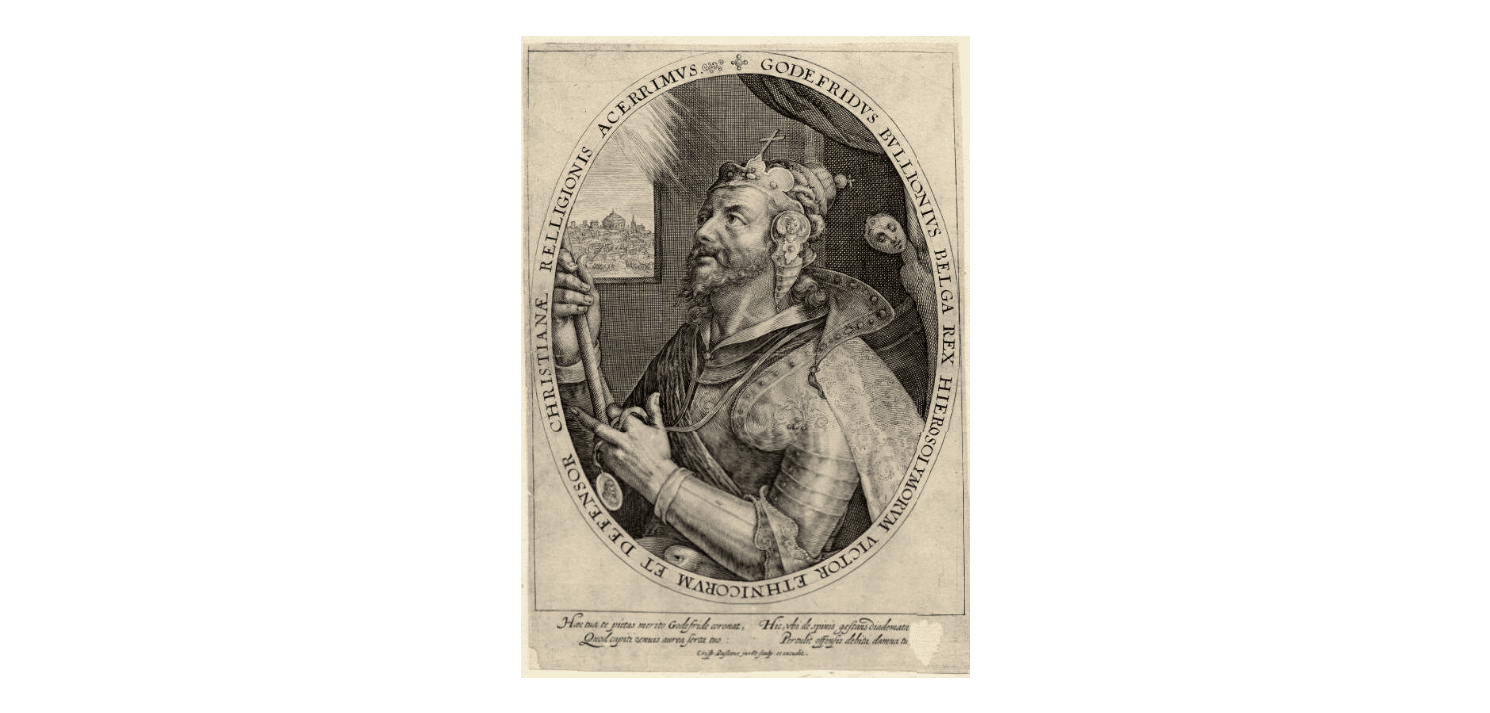
- The most important of the Crusader States was established by Godfrey of Bouillon, Duke of Lower Lorraine, in 1099.
- The Kingdom of Jerusalem controlled a narrow strip of coastal lands from Jaffa in the south to Beirut in the north.
- Various fiefdoms were under the control of the kingdom, including Acre, Tyre, Nablus, Sidon and Caesarea
- Godfrey was the first King of Jerusalem while the Norman Arnulf of Choques was made patriarch or bishop of Jerusalem.
- Similar to other medieval monarchies in contemporary Europe, the Crusader States was governed by either the king, prince or count who held absolute power.
- Due to the rulers’ dependency on nobles to provide warriors for the defence of the states, councils of consultation were held.
- The Crusader States applied the ideal feudal law wherein lordship was highly dependent on one’s loyalty to the ruler.
- With the establishment of the states, Turkish and Arab elites either fled or were killed, while small populations of peasants, craftsmen, and traders retained.
- Trade flourished regardless of politics or race as goods continued to travel from the east and west and vice versa.
- In fact, larger cities became thriving commercial centres with many foreign merchants either temporarily or permanently settled in them.
Challenges in and decline of the Crusader States
- Following the revival of Jerusalem, most of the crusaders considered their pilgrimage concluded and returned home. This left the Crusader States vulnerable to Muslim attacks that aimed to recapture those reborn lands.
- Apart from the Muslim aggression, other difficulties were encountered in the states.
- Clash of Culture: The population was varied. People spoke different languages which resulted in lack of integration and common tradition.
- Alienation: Due to openness and tolerance of Muslim and Jewish population, later pilgrims and settlers felt alienated.
- Shortage of manpower: Massive deaths due to diseases and battles left the Crusader States with limited manpower. Moreover, a high mortality rate among children resulted in a long-term shortage of manpower.
- Succession: In the Kingdom of Jerusalem, following the death of Godfrey of Bouillon, he had no child to succeed him, which created dissatisfaction as his brother claimed the throne and faced the same problem.
- Long frontiers: With few men, it was difficult to man and protect the long borders of the Crusader States which stretched from the northern frontier of Edessa down to the southern frontier of Jerusalem.
- Dominant Muslim population: Christians were outnumbered by Muslims. Trust issues with the Muslim population was among the pressing difficulties.
- The Muslim leaders regrouped and made serious attempts to regain the losses of the First Crusade. Edessa fell to the Muslims in 1144.
- In response, succeeding Crusades were launched to fight for the Holy Land, albeit with smaller groups of armed pilgrims.
- The Crusades had mixed results and at times great disappointment, as several regions were recaptured by the Muslims
- The states never really recovered from 1244. Antioch was captured in 1268 and Tripoli in 1289.
- In 1291 with the fall of Acre, the capital of the Kingdom of Jerusalem, what was left of the Crusaders States was absorbed into the Mamluk Sultanate.

